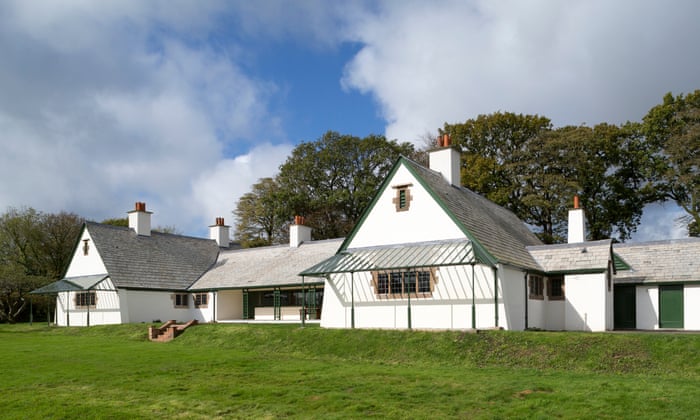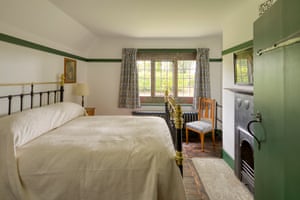Enjoy your stay!

Pleurisy, fracture at elbow, scalded buttocks, horse bite – who knew that a list of ailments on a hospital’s patient register could be so gripping? The one I found in my holiday accommodation (newly renovated Winsford Cottage Hospital in Devon) told the stories of people from a dozen local parishes. Within its handwritten pages I read of first world war soldiers with trench fever, second world war evacuees with asthma, plus farmers, labourers, cooks and teachers who had contrived to injure themselves in all manner of ways – and scores upon scores of women giving birth. Encouragingly, the patients whose discharge date is followed by the remarks “Cured”, “Much benefited” or “Satisfactory” far outnumber those with the more solemn “Died”.
That would doubtless have pleased Maria Medley. She was the wealthy benefactor who built what is now the Winsford Centre at Halwill Junction, 10 miles from Okehampton in 1899-1900 as a memorial to her husband George, who had passed away the previous year. In doing so, she transformed the lives of locals who couldn’t afford to call a doctor and often died of curable illnesses as a result. Back then, this part of Devon was busy. Halwill Junction takes its name from a now-disappeared railway station where lines from Barnstaple, Padstow, Bude and Exeter converged until Dr Beeching axed the lot in the 1960s. Unusually for such a rural village, it’s still easily accessible by public transport – I took a bus from Exeter St David’s station, passing Dartmoor on the way.


Pleurisy, fracture at elbow, scalded buttocks, horse bite – who knew that a list of ailments on a hospital’s patient register could be so gripping? The one I found in my holiday accommodation (newly renovated Winsford Cottage Hospital in Devon) told the stories of people from a dozen local parishes. Within its handwritten pages I read of first world war soldiers with trench fever, second world war evacuees with asthma, plus farmers, labourers, cooks and teachers who had contrived to injure themselves in all manner of ways – and scores upon scores of women giving birth. Encouragingly, the patients whose discharge date is followed by the remarks “Cured”, “Much benefited” or “Satisfactory” far outnumber those with the more solemn “Died”.
That would doubtless have pleased Maria Medley. She was the wealthy benefactor who built what is now the Winsford Centre at Halwill Junction, 10 miles from Okehampton in 1899-1900 as a memorial to her husband George, who had passed away the previous year. In doing so, she transformed the lives of locals who couldn’t afford to call a doctor and often died of curable illnesses as a result. Back then, this part of Devon was busy. Halwill Junction takes its name from a now-disappeared railway station where lines from Barnstaple, Padstow, Bude and Exeter converged until Dr Beeching axed the lot in the 1960s. Unusually for such a rural village, it’s still easily accessible by public transport – I took a bus from Exeter St David’s station, passing Dartmoor on the way.
Winsford’s designer was CFA Voysey, a friend of the Medleys and one of the most influential arts and crafts architects of his day. He almost exclusively designed grand houses, which explains why Winsford (with its striking triple gables and long band of mullioned windows) looks decidedly unlike a hospital. Barbara, the property’s housekeeper, pointed out to me that he’d even taken the trouble to make all the doors deliberately wide and low, “so they didn’t remind people of the shape of coffins”. It’s no wonder many of those who came to view the hospital when it opened in 1900 wrote in the visitors’ book that they wished they could live in it.
I found the interior oddly reminiscent of an early video game. Standing in the entrance hall I faced a long, wide corridor with myriad identical doors off it and no way of knowing what was behind them, until I pushed down on their latches and peered in. Along with four bedrooms, I discovered a tiny study, three bathrooms (two of which had baths, in one of which I later enjoyed gloriously languorous soaks), a flashily equipped kitchen, a delightfully formal dining room and a lounge with sofas so generously proportioned that I could almost have disappeared into them. Blissfully, there was neither a television nor wifi. In their place I found a library curated by one of the Landmark Trust’s librarians, a chronicle of the hospital written by historian Caroline Stanford, and that fascinating register of patients.

It was difficult to believe that the building – which closed in 1998 – had been in a state of advanced decay as recently as last year, when the Landmark Trust took it over. Using skilled local tradesmen and volunteers, it took Winsford back to how it would have looked in 1914, when its seven beds began to be filled by wounded and ailing soldiers. Cement was removed to reveal the sand-coloured mosaic floor; the Cornish Delabole slate roof was overhauled; the original fireplaces (decorated with Voysey’s celebrated elongated hearts) were carefully preserved; and the white-and-dark-green colour scheme was reinstated. In all, the trust spent £1.5m on restoration, creating an extensive holiday property while maintaining the east wing for community use (here one room has been mocked up as an early-20th-century ward). (...)
Read the whole article clicking here:

No hay comentarios:
Publicar un comentario